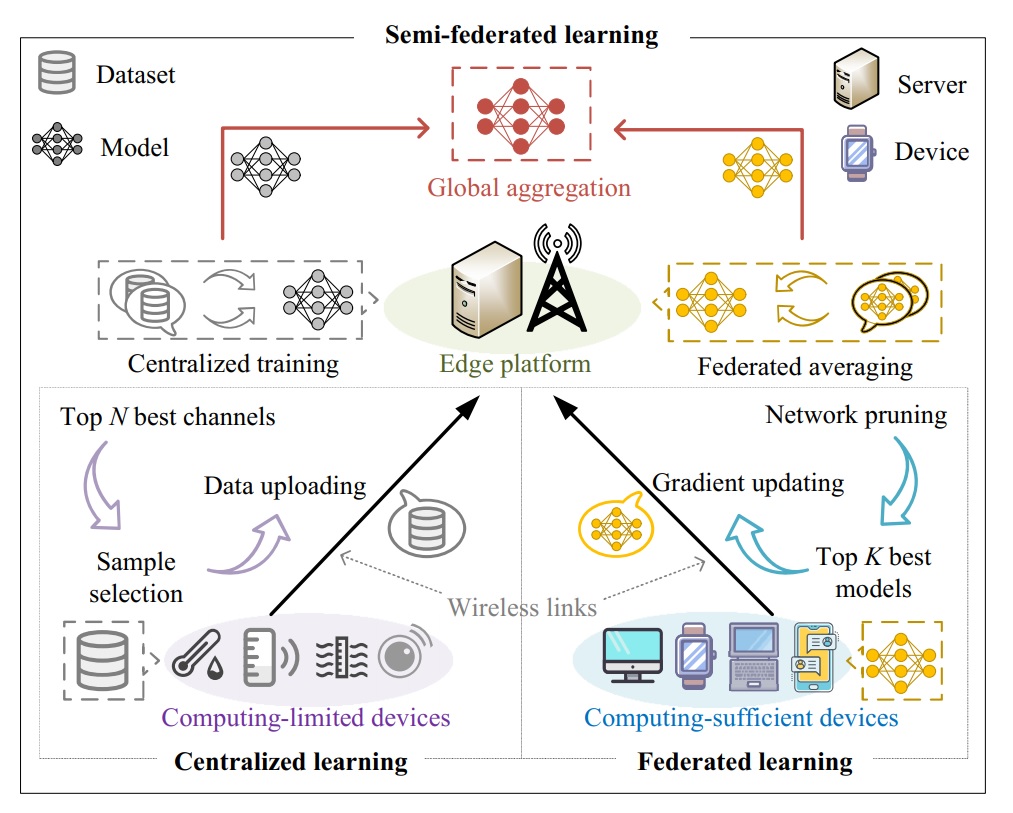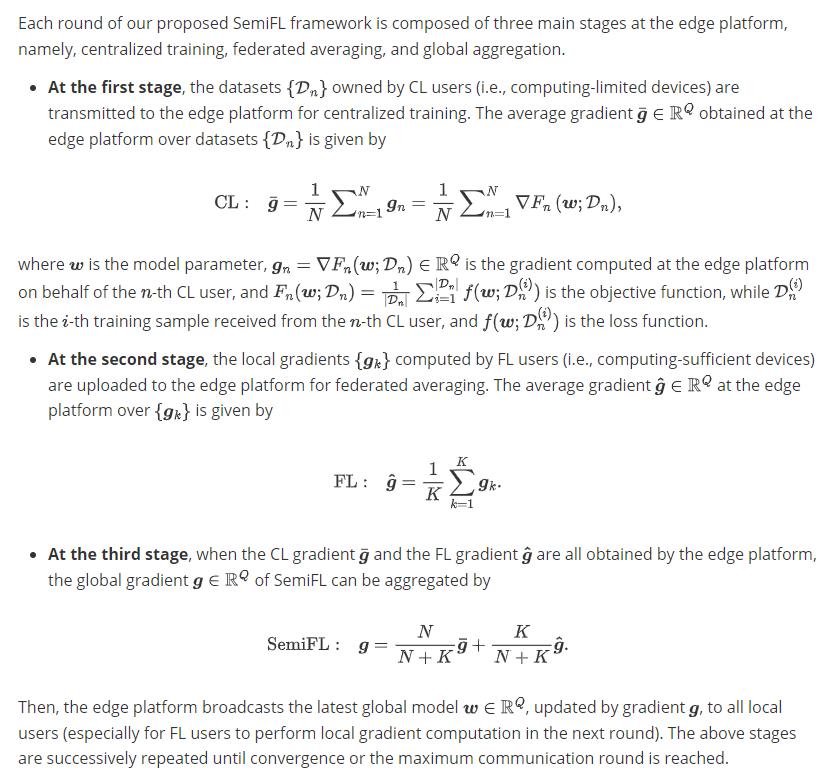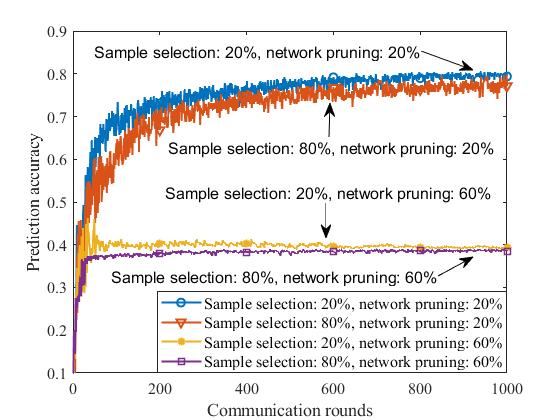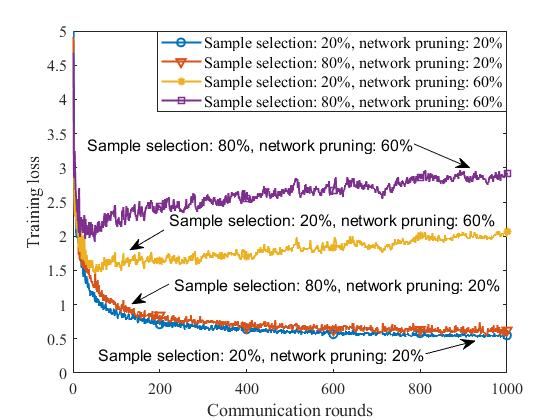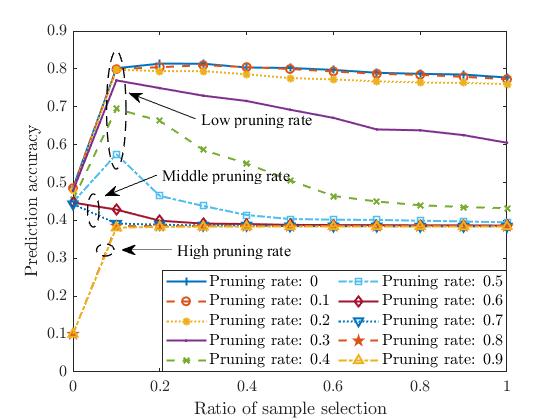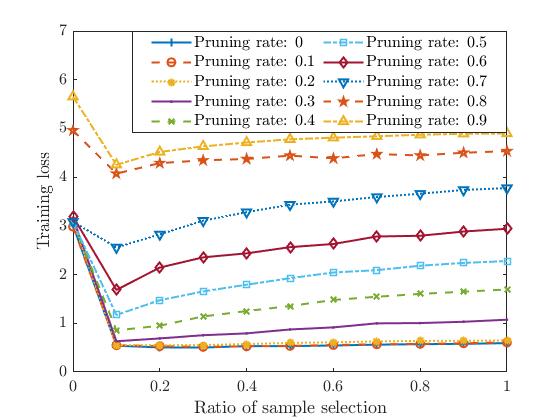Note: All code and data are used for the following paper:
Title: Semi-Federated Learning for Collaborative Intelligence in Massive IoT Networks
Author: Wanli Ni, Jingheng Zheng, and Hui Tian
Institution: Beijing University of Posts and Telecommunications
In this paper, we propose a novel semi-federated learning (SemiFL) concept that seamlessly integrates the conventional centralized learning (CL) and federated learning (FL) into a harmonized framework.
@article{Ni2022Semi,
author = {Ni, Wanli and Zheng, Jingheng and Tian, Hui},
title = {Semi-Federated Learning for Collaborative Intelligence in Massive IoT Networks},
journal = {IEEE Internet of Things Journal},
year = {2023},
month = {March},
volume={10},
number={13},
pages={11942-11943},
doi={10.1109/JIOT.2023.3253853}
}
1. Parameter Settings
| Parameters | Description | Value |
|---|---|---|
| Neural network | An MLP with three hidden layers | [784 50 100 50 10] |
| Dataset | Fashion-MNIST | 10 categories (6,000 each) |
| Distribution | Non-independent and identically distributed (non-IID) data | Each device has one type of samples |
N |
Number of computing-limited devices | 4 |
K |
Number of computing-sufficient devices | 6 |
S |
Sample selection | [0, 1] |
P |
Network pruning | [0, 1) |
T |
Number of communication rounds | 1,000 |
| Learning rate | 0.1 |
2. Benchmarks
| Names | Description | File |
|---|---|---|
Baseline 1 |
Centralized learning (CL) | centralized_learning.m |
Baseline 2 |
Federated learning (FL) | federated_learning.m |
Baseline 3 |
SemiFL with |
semi_federated_learning_ideal.m |
3. The First Group of Simulation Results
Discussion #1 (Learning performance versus the number of communication rounds): In the experiments, we demonstrate the learning performance achieved by the proposed SemiFL framework and different benchmarks under the non-IID setting. From the figures in the first group of simulation results, the following two key observations can be drawn.
- The proposed SemiFL framework without sample selection and network pruning (i.e., Baseline 3) outperforms FL (i.e., Baseline 2), and achieves the similar performance to CL (i.e., Baseline 1) which has higher communication overhead due to the transmission of the entire dataset.
- Although sample selection and network pruning can further reduce the communication overhead of SemiFL, they also degrade the achievable learning performance in terms of prediction accuracy and training loss.
4. The Second Group of of Simulation Results
Discussion #2 (Learning performance versus the number of communication rounds under different settings of sample selection and network pruning): From the figures in the second group of simulation results, we observe the following two phenomena.
- One the one hand, when the sample selection ratio of these computing-limited devices is fixed, increasing the network pruning rate will deteriorate the learning performance in terms of prediction accuracy and training loss. This is because networking pruning degrades the learning ability of these computing-limited devices, but has the benefits of reducing communication overhead and saving local computation time.
- On the other hand, when the network pruning rate is fixed, lowering sample selection ratio is beneficial to improve the learning performance under the non-IID data settings. This is different from what we observed in the IID cases considered by our previous papers [4, 6, 10]. Therefore, in the following, we conduct more experiments to show the achievable learning performance under finer settings of sample selection and network pruning.
5. The Third Group of Simulation Results
Discussion #3 (Learning performance under different sample selection and network pruning ratios): From the third group of simulation results, we observe the following three key insights when varying the values of sample selection and network pruning.
-
When the network pruning rate is low (e.g.,
$0 \le P < 0.6$ ), it can be seen that the prediction accuracy first increases with the sample selection ratio, and then decreases with it after the sample selection ratio is greater than 0.1. This is mainly because when the pruning rate is low, the learning ability of the used multi-layer perceptron (MLP) has not been fully developed, so uploading some raw data for centralized learning can help it further improve the prediction accuracy. However, due to the non-IID setting, the gradient descent directions of CL and FL are inconsistent, so uploading more raw data will make the performance worse. That is to say, in the considered non-IID case, it is not that the more raw data devices upload, the better the model performance will be, but there is an optimal sample selection ratio. -
When the network pruning rate is middle (e.g.,
$0.6 \le P < 0.8$ ), the learning ability of the MLP is insufficient to complete the multi-category classification task. Therefore, the prediction accuracy decreases with the ratio of sample selection. It should be clarified that the higher the sample selection ratio, the more raw data will be uploaded. A popular explanation for this is not to give a dumb kid too hard homework. -
When the network pruning rate is high (e.g.,
$0.8 \le P < 1$ ), the learning ability of the MLP is ignorable. Therefore, the total learning performance just depends on the CL part, and its performance reaches the optimal level at the sample selection ratio of 0.1.
code/
├── Fashion_MNIST/
├── dataset pre-processing tools/
├── non_iid_labels.mat
├── non_iid_samples.mat
├── test_data_all.mat
├── test_label_all.mat
├── train_data_all.mat
├── train_label_all.mat
├── centralized_learning.m
├── federated_learning.m
├── semi_federated_learning_ideal.m
├── semi_federated_learning.m
├── get_selected_CL_devices.m
├── get_selected_FL_devices.m
├── get_locations.m
├── get_channels.m
├── get_gradient.m
├── get_pruned_model.m
├── get_initial_model.mat
└── performance_vs_rounds/
data/
├── CL_without_sampling.mat
├── FL_with_pruning.mat
├── SemiFL_without_sampling_and_pruning.mat
├── SemiFL_with_sampling_and_pruning.mat
├── draw_accuracy.m
└── draw_loss.m
Note: The code in this repository is primarily used to generate the simulation results in the first group. The results in the second and third groups can be easily obtained by changing the value settings for sample selection and network pruning.
